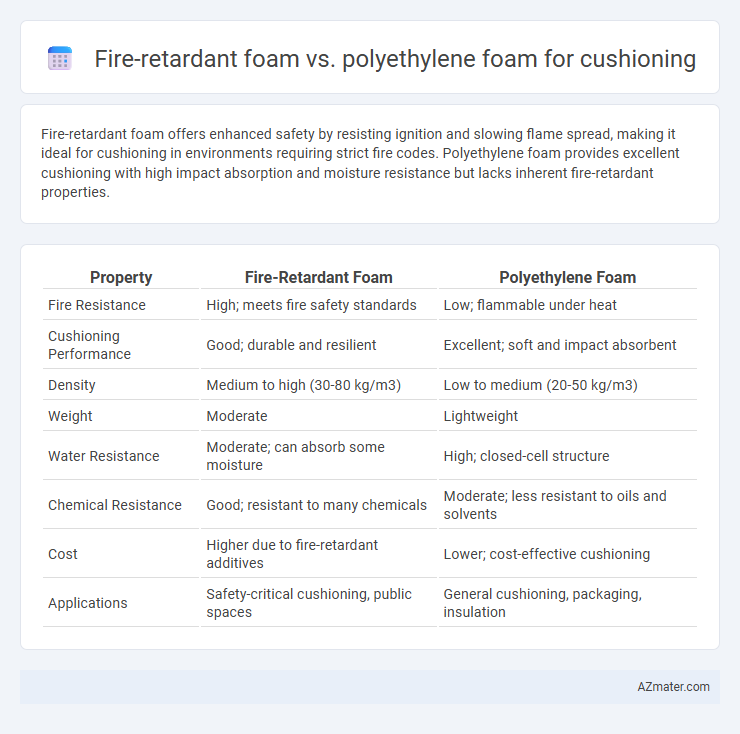Fire-retardant foam offers enhanced safety by resisting ignition and slowing flame spread, making it ideal for cushioning in environments requiring strict fire codes. Polyethylene foam provides excellent cushioning with high impact absorption and moisture resistance but lacks inherent fire-retardant properties.
Table of Comparison
| Property | Fire-Retardant Foam | Polyethylene Foam |
|---|---|---|
| Fire Resistance | High; meets fire safety standards | Low; flammable under heat |
| Cushioning Performance | Good; durable and resilient | Excellent; soft and impact absorbent |
| Density | Medium to high (30-80 kg/m3) | Low to medium (20-50 kg/m3) |
| Weight | Moderate | Lightweight |
| Water Resistance | Moderate; can absorb some moisture | High; closed-cell structure |
| Chemical Resistance | Good; resistant to many chemicals | Moderate; less resistant to oils and solvents |
| Cost | Higher due to fire-retardant additives | Lower; cost-effective cushioning |
| Applications | Safety-critical cushioning, public spaces | General cushioning, packaging, insulation |
Introduction to Cushioning Foams
Fire-retardant foam offers enhanced safety by resisting ignition and slowing flame spread, making it ideal for applications requiring stringent fire codes. Polyethylene foam provides excellent shock absorption and durability with a closed-cell structure that resists moisture and chemicals. Both foams serve crucial roles in cushioning, with fire-retardant variants prioritized in environments with fire safety considerations, while polyethylene foam excels in general-purpose protective packaging and cushioning.
What Is Fire-Retardant Foam?
Fire-retardant foam is a specially engineered cushioning material designed to resist ignition and slow the spread of flames, enhancing safety in applications requiring fire protection. Unlike polyethylene foam, which is primarily valued for its lightweight cushioning and shock absorption properties, fire-retardant foam contains chemical additives that reduce flammability and emit lower smoke levels during combustion. This makes fire-retardant foam ideal for use in transportation, upholstery, and construction where compliance with strict fire safety standards is critical.
Understanding Polyethylene Foam
Polyethylene foam is a lightweight, closed-cell cushioning material known for its excellent impact absorption and durability, making it ideal for packaging and protective applications. Unlike fire-retardant foam, polyethylene foam is inherently non-flammable but does not possess specialized fire-resistant additives, which limits its effectiveness in high-risk fire environments. Its moisture resistance and chemical stability ensure long-lasting cushioning performance, although fire-retardant foam remains superior where enhanced fire safety compliance is mandatory.
Key Properties Comparison: Fire-Retardant vs Polyethylene Foam
Fire-retardant foam offers superior flame resistance with compliance to stringent fire safety standards such as FMVSS 302 and ASTM E84, making it ideal for applications requiring enhanced fire protection. Polyethylene foam provides excellent cushioning through high impact absorption and durability, featuring closed-cell structure that resists moisture, chemicals, and wear. While fire-retardant foam prioritizes safety with reduced flammability and smoke emission, polyethylene foam excels in lightweight support and resilience for general-purpose cushioning needs.
Safety and Fire Resistance
Fire-retardant foam offers superior safety by significantly reducing the risk of ignition and flame spread during a fire, making it an ideal choice for cushioning in environments with strict fire safety regulations. Polyethylene foam, while lightweight and durable, is inherently more combustible and typically lacks inherent fire-resistant properties unless specially treated. In applications prioritizing fire resistance, fire-retardant foam provides enhanced protection, minimizing toxic smoke emission and improving occupant safety during fire emergencies.
Performance in Cushioning Applications
Fire-retardant foam offers superior safety by slowing the spread of flames, making it ideal for applications requiring enhanced fire resistance without compromising cushioning performance. Polyethylene foam excels in resilience and impact absorption, providing consistent cushioning with high durability and water resistance in various environments. Both foams deliver effective cushioning properties, but fire-retardant foam prioritizes safety compliance while polyethylene foam emphasizes long-term durability and versatility.
Durability and Longevity
Fire-retardant foam exhibits superior durability and longevity compared to polyethylene foam due to its enhanced resistance to heat, flame, and chemical degradation, making it ideal for safety-critical cushioning applications. Polyethylene foam, while lightweight and providing excellent impact absorption, tends to compress and degrade faster under continuous stress and exposure to UV light, reducing its long-term cushioning performance. Fire-retardant foam's structural integrity and resistance to environmental factors ensure extended lifespan and consistent shock absorption, significantly benefiting products requiring sustained protective cushioning.
Environmental Impact and Sustainability
Fire-retardant foam often contains chemical additives that can release toxic substances during production and disposal, raising environmental concerns. Polyethylene foam is typically more recyclable and can be produced from recycled materials, reducing landfill waste and energy consumption. Choosing polyethylene foam for cushioning supports sustainability goals through improved recyclability and lower ecological footprint compared to fire-retardant alternatives.
Cost Considerations
Fire-retardant foam typically incurs higher costs due to specialized chemical treatments and compliance with fire safety standards, making it a more expensive option for cushioning. Polyethylene foam generally offers a cost-effective solution, with lower raw material and production expenses, suitable for standard cushioning needs. Budget-conscious buyers must weigh the premium pricing of fire-retardant foam against its enhanced safety features versus the affordability and adequate performance of polyethylene foam.
Choosing the Right Foam for Cushioning Needs
Fire-retardant foam offers enhanced safety by resisting ignition and slowing flame spread, making it ideal for cushioning in environments with strict fire safety regulations. Polyethylene foam provides excellent cushioning with high resilience, water resistance, and durability, suitable for general-purpose packaging and impact protection. Selecting the right foam depends on balancing fire retardancy requirements with cushioning performance, weight, and environmental exposure.

Infographic: Fire-retardant foam vs Polyethylene foam for Cushioning
 azmater.com
azmater.com